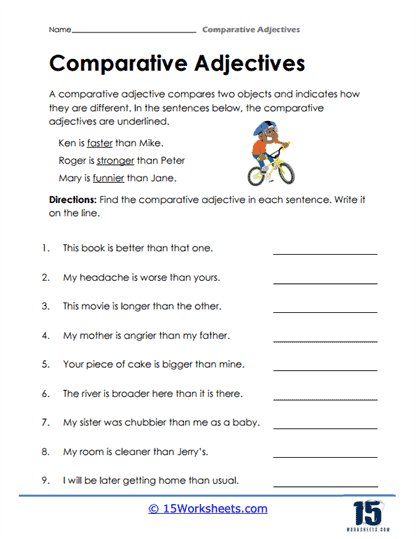
Mastering Comparisons: The Indispensable Role of Using Comparative Adjectives Worksheets
Language is a dynamic tool, constantly adapting to express nuanced thoughts, feelings, and observations. Among its many facets, the ability to compare and contrast is fundamental. Whether we are discussing the merits of two different products, describing the weather patterns between seasons, or simply stating a preference, comparative adjectives are the linguistic backbone that allows us to articulate these differences. For English language learners, mastering these grammatical structures is crucial for achieving fluency and precision. This is where the strategic implementation of using comparative adjectives worksheet becomes an invaluable pedagogical asset.
Comparative adjectives are words used to compare two nouns, indicating which one possesses a particular quality to a greater or lesser degree. Typically, they are formed by adding "-er" to short adjectives (e.g., tall becomes taller) or by placing "more" before longer adjectives (e.g., beautiful becomes more beautiful). Irregular forms, such as good/better and bad/worse, add another layer of complexity. Given this array of rules and exceptions, structured practice is not merely helpful; it is essential. Worksheets provide that structured, repeatable environment for learners to internalize these rules and apply them confidently.

The Foundational Importance of Comparative Adjectives
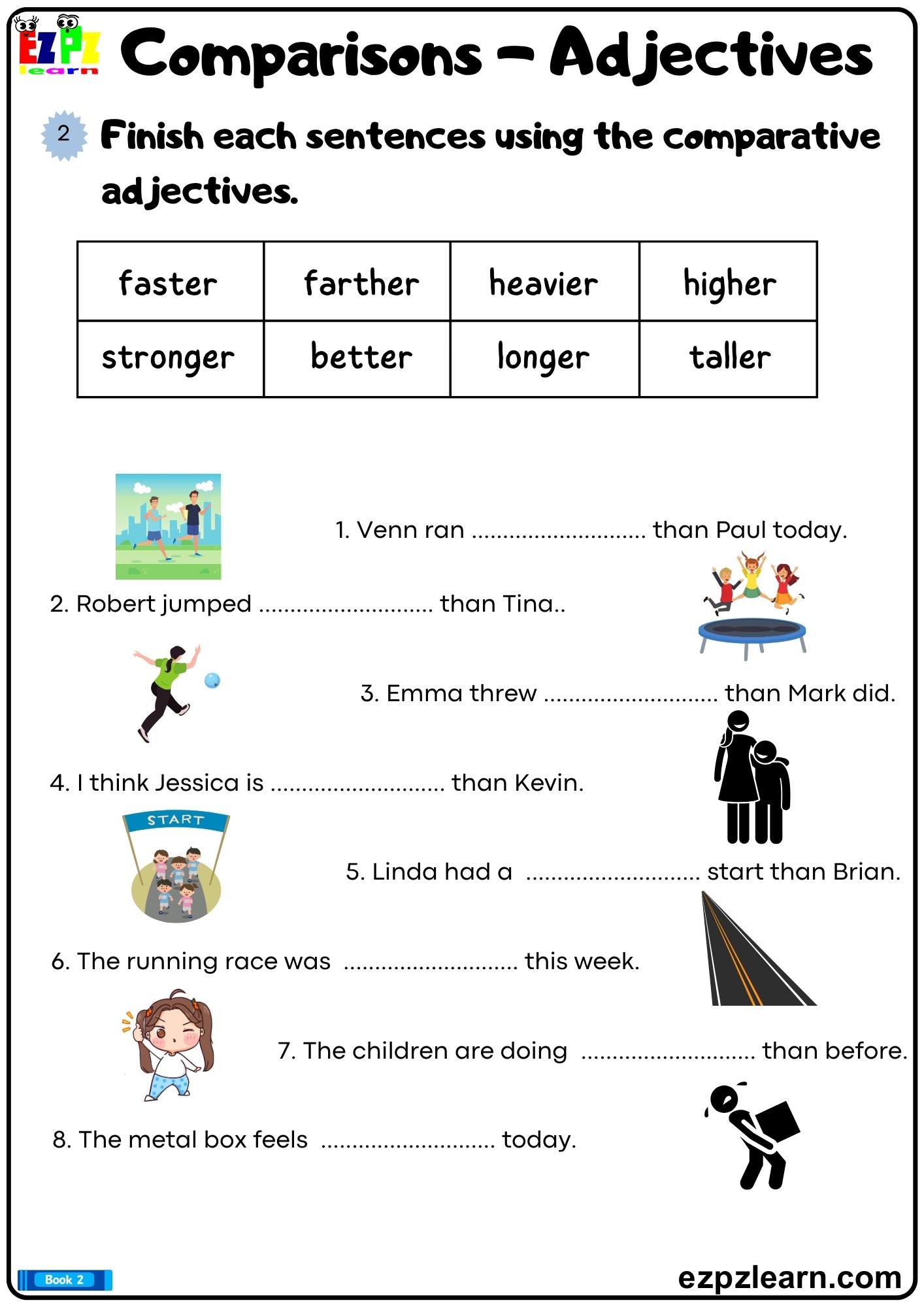
Before delving into the specifics of worksheets, it’s vital to understand why comparative adjectives hold such a significant place in English grammar. They allow us to:

- Express Preferences and Opinions: "This coffee is stronger than that one." "I find classical music more relaxing than pop."
- Describe Differences: "The old house was smaller than the new apartment." "Winter is colder than autumn."
- Make Informed Choices: "Which option is cheaper?" "Is the express train faster?"
- Narrate and Elaborate: They add depth and detail to descriptions, making stories and explanations more vivid and informative.
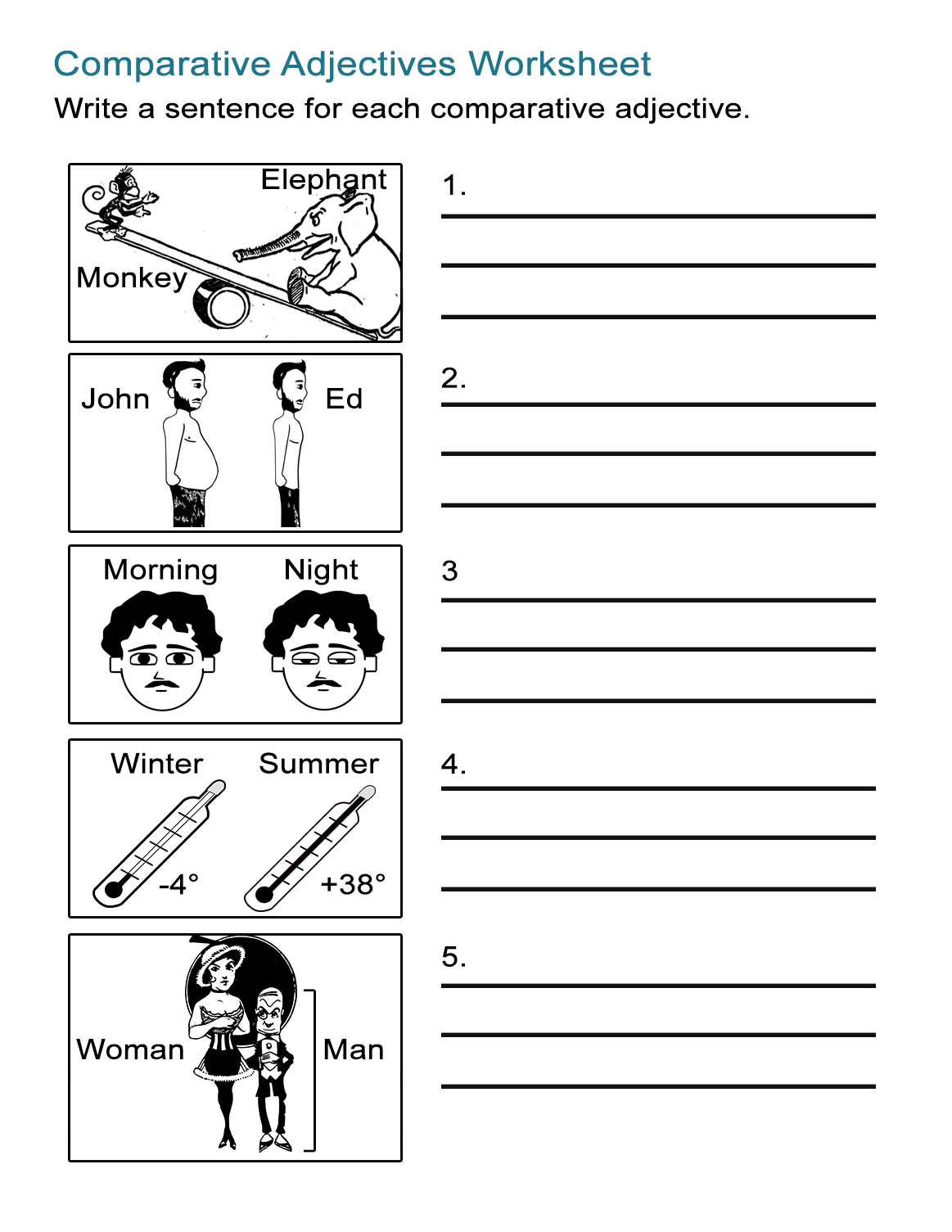
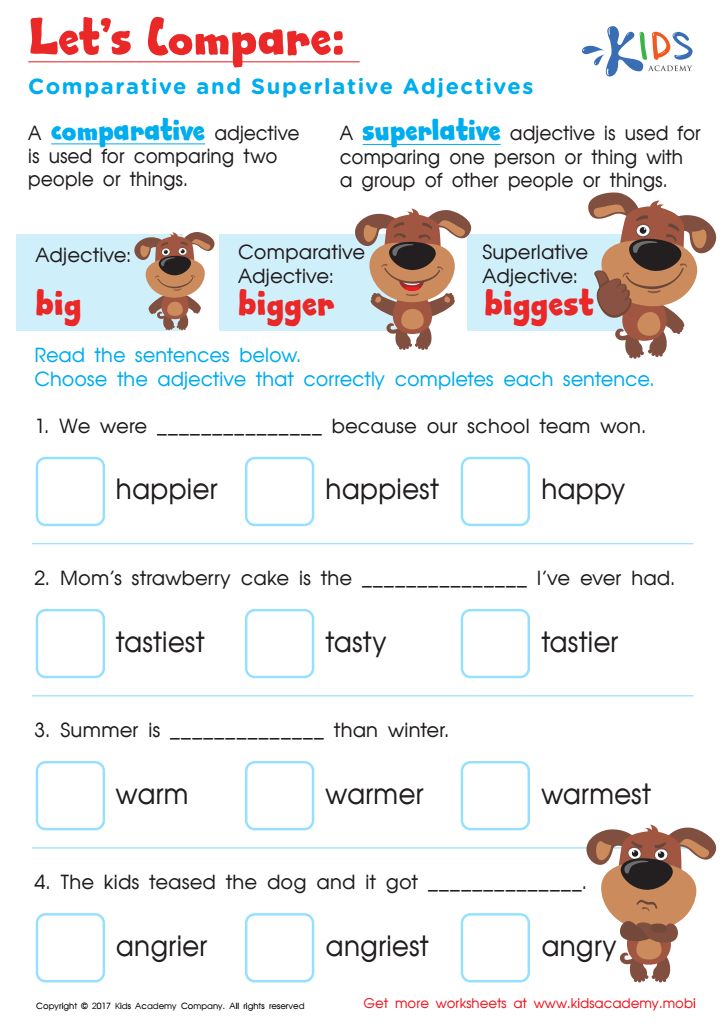
Without a solid grasp of comparatives, a learner’s ability to communicate effectively and naturally will be significantly hampered. They might resort to cumbersome circumlocutions or simply fail to convey the intended meaning of comparison.

Why Worksheets Are Indispensable for Comparative Adjectives
In an age of digital tools and interactive apps, the humble worksheet might seem antiquated, but its pedagogical value remains immense, especially when using comparative adjectives worksheet. Here’s why:
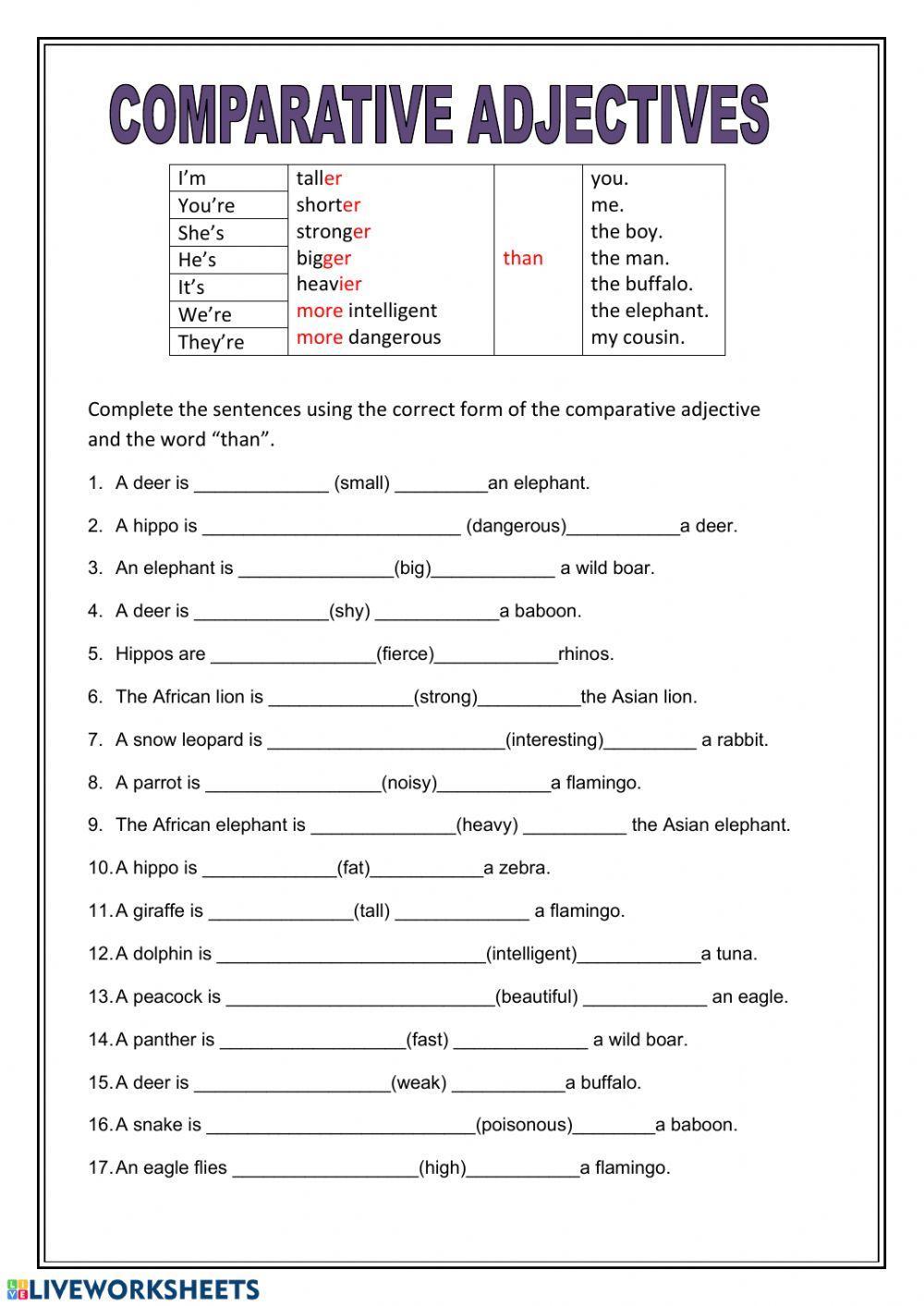
- Structured Practice: Worksheets offer a systematic approach to learning. They break down the concept into manageable parts, allowing learners to focus on one rule or one type of adjective at a time. This step-by-step progression builds confidence.
- Repetition for Reinforcement: Language acquisition thrives on repetition. Worksheets provide ample opportunities for learners to practice forming and using comparative adjectives multiple times, solidifying the rules in their minds through muscle memory (for writing) and cognitive recall.
- Immediate Feedback (with Answer Keys): Many worksheets come with answer keys, enabling self-correction. This immediate feedback loop is crucial for learning, as it allows learners to identify and rectify mistakes on the spot, preventing the reinforcement of errors.
- Assessment Tool: For educators, worksheets are excellent diagnostic tools. They quickly reveal which rules or irregular forms learners are struggling with, allowing teachers to tailor subsequent lessons to address specific weaknesses.
- Variety of Exercises: A well-designed worksheet isn’t just about filling in blanks. It can incorporate matching, sentence completion, error identification, picture-based comparisons, and even short creative writing prompts, catering to different learning styles and keeping engagement high.
- Tangible Progress: Completing a worksheet provides a sense of accomplishment. Learners can physically see their progress, which is a great motivator.


Designing and Selecting Effective Comparative Adjectives Worksheets
Not all worksheets are created equal. To maximize the benefits of using comparative adjectives worksheet, educators and learners should consider the following design principles:
- Clarity and Simplicity: Instructions should be unambiguous. The layout should be clean and easy to follow, minimizing distractions.
- Progressive Difficulty: Start with basic "adjective + -er" and "more + adjective" structures, then introduce irregular forms, and finally move to more complex sentence constructions or scenarios requiring critical thinking.
- Contextual Relevance: While isolated grammar drills have their place, exercises that place comparative adjectives in meaningful contexts (e.g., comparing two cities, two animals, or two historical events) make the learning more engaging and applicable.
- Inclusion of Irregular Forms: These are often the trickiest for learners. Dedicated sections or mixed exercises that specifically target good/better, bad/worse, far/farther/further, etc., are essential.
- Focus on "Than": A common mistake is omitting "than" when making a comparison. Worksheets should consistently reinforce the need for "than" in comparative sentences.
- Visual Aids: For younger learners or visual learners, incorporating pictures (e.g., comparing the height of two trees, the size of two animals) can make the exercises more intuitive and fun.
- Ample Space for Answers: Ensure there’s enough room for learners to write their responses clearly.
- Answer Key Availability: As mentioned, this is crucial for self-correction and independent learning.
Types of Exercises Found in Comparative Adjectives Worksheets
A comprehensive using comparative adjectives worksheet often includes a variety of exercise types to reinforce learning from multiple angles:
- Fill-in-the-Blanks: The most common type, where learners complete sentences by inserting the correct comparative form of a given adjective.
- Example: The elephant is __ (big) than the mouse.
- Sentence Transformation: Learners rewrite sentences using comparative adjectives.
- Example: Sarah is smart. John is very smart. -> John is __ Sarah.
- Error Identification and Correction: Learners identify grammatical errors (e.g., "more better," missing "than") and correct them. This develops critical thinking and an eye for detail.
- Matching Exercises: Matching an adjective with its correct comparative form, or matching a sentence fragment with its appropriate completion.
- Picture-Based Comparisons: Learners describe differences between two images using comparative adjectives. This integrates visual processing with language skills.
- Dialogue Completion: Filling in missing parts of a conversation using comparatives, making the practice more communicative and realistic.
- Creative Writing Prompts: Asking learners to write short paragraphs comparing two items, people, or places, encouraging free expression while applying the grammatical rules.
- Scrambled Sentences: Rearranging words to form grammatically correct comparative sentences.
Maximizing the Impact: Beyond Just Handing Out Worksheets
While worksheets are powerful tools, their effectiveness is amplified when integrated into a broader teaching methodology.
- Pre-teaching and Review: Always introduce or review the rules of comparative adjectives before assigning a worksheet. Go over examples and clarify common pitfalls.
- Guided Practice: Begin by doing the first few exercises of a worksheet together as a class. This allows learners to ask questions and ensures they understand the task.
- Independent Practice: Allow sufficient time for learners to complete the worksheet individually. This fosters self-reliance and allows them to work at their own pace.
- Peer Correction and Discussion: After completion, encourage learners to swap worksheets and correct each other’s work using the answer key. This promotes collaborative learning and reinforces understanding. Follow up with a class discussion of common errors.
- Integration with Speaking and Writing: Don’t let the learning stop at the worksheet. Encourage learners to use comparative adjectives in spoken activities (e.g., comparing classmates, describing their favorite foods) and in written assignments (e.g., comparing two literary characters, writing a review comparing two movies).
- Gamification: Turn worksheet exercises into games. For instance, a "comparative race" where teams compete to complete sentences correctly, or a "comparative bingo" where learners mark squares as they hear or use specific comparative adjectives.
Addressing Common Challenges
Learners often face specific hurdles when using comparative adjectives:
- Over-generalization: Applying "-er" to long adjectives (e.g., "beautifuller") or "more" to short ones (e.g., "more fast"). Solution: Emphasize the syllable rule and provide clear examples.
- Forgetting "than": Often, learners omit "than" in their comparisons. Solution: Highlight "than" as an essential partner to the comparative adjective and include exercises that specifically penalize its absence.
- Double Comparatives: Using both "more" and "-er" (e.g., "more better"). Solution: Explicitly teach that only one form is correct and provide drills for correction.
- Irregular Forms: These simply require memorization. Worksheets with repetitive drills focusing on good/better, bad/worse, etc., are crucial.
Conclusion
The journey to English fluency is paved with consistent practice and the mastery of grammatical structures. Among these, comparative adjectives stand out for their utility in everyday communication. The strategic implementation of using comparative adjectives worksheet provides the structured, repeatable, and feedback-rich environment essential for learners to internalize these rules, overcome common pitfalls, and confidently express comparisons. From basic drills to creative writing prompts, these worksheets are not just busywork; they are fundamental tools that empower learners to describe the world around them with greater precision, nuance, and communicative power, ultimately fostering a deeper and more effective engagement with the English language.
